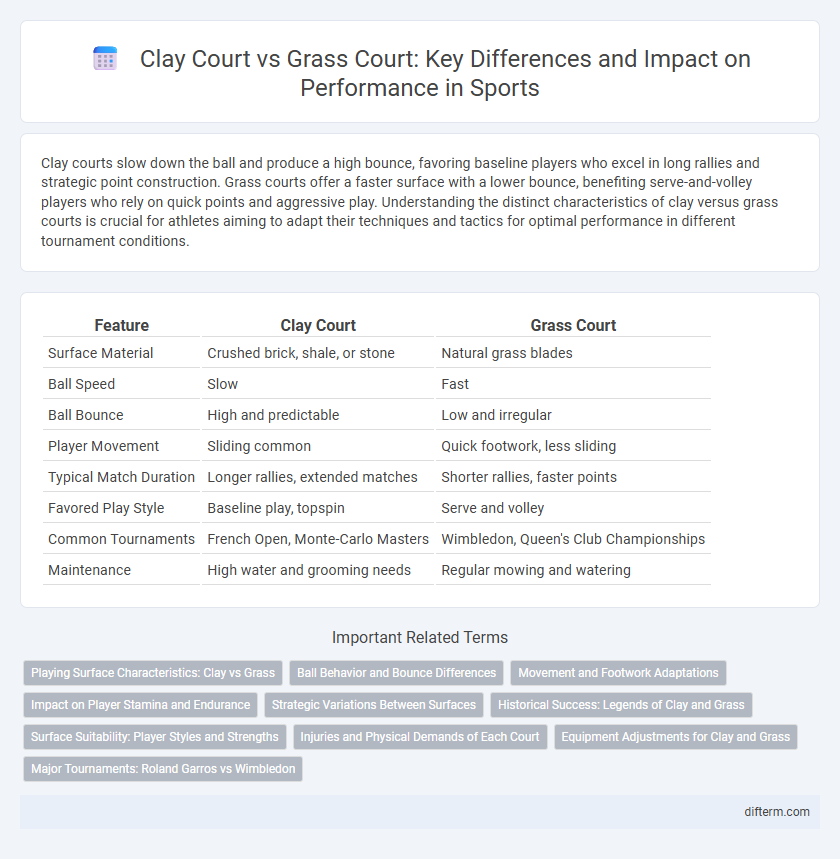Clay courts slow down the ball and produce a high bounce, favoring baseline players who excel in long rallies and strategic point construction. Grass courts offer a faster surface with a lower bounce, benefiting serve-and-volley players who rely on quick points and aggressive play. Understanding the distinct characteristics of clay versus grass courts is crucial for athletes aiming to adapt their techniques and tactics for optimal performance in different tournament conditions.
Table of Comparison
| Feature | Clay Court | Grass Court |
|---|---|---|
| Surface Material | Crushed brick, shale, or stone | Natural grass blades |
| Ball Speed | Slow | Fast |
| Ball Bounce | High and predictable | Low and irregular |
| Player Movement | Sliding common | Quick footwork, less sliding |
| Typical Match Duration | Longer rallies, extended matches | Shorter rallies, faster points |
| Favored Play Style | Baseline play, topspin | Serve and volley |
| Common Tournaments | French Open, Monte-Carlo Masters | Wimbledon, Queen's Club Championships |
| Maintenance | High water and grooming needs | Regular mowing and watering |
Playing Surface Characteristics: Clay vs Grass
Clay courts slow down the ball and produce a high bounce, favoring baseline players and longer rallies due to the surface's granular texture and moisture retention. Grass courts offer a faster game with low, unpredictable bounces because of the natural grass blades' softness and slipperiness, benefiting serve-and-volley players. The distinct friction levels and ball behavior on each surface significantly impact player movement, shot selection, and match strategy.
Ball Behavior and Bounce Differences
Clay courts slow down the ball and produce a higher bounce due to their loose surface, which increases friction and reduces ball speed. Grass courts offer a faster, lower bounce as the ball skids on the smooth, tightly packed grass blades, resulting in shorter reaction times for players. These differences significantly affect player strategies and shot selection during matches.
Movement and Footwork Adaptations
Clay courts slow down ball speed and produce higher bounces, requiring players to adopt sliding footwork and enhanced balance to maintain control during movement. The softer, uneven surface demands longer strides and increased stamina, as players must adjust to slower ball reactions and extended rallies. In contrast, grass courts offer faster ball speeds with lower, skidding bounces, prompting quicker, shorter steps and rapid directional changes to optimize agility and reaction time.
Impact on Player Stamina and Endurance
Clay courts slow down the ball and produce higher bounce, requiring players to engage in longer rallies that test stamina and endurance more intensely than grass courts. Grass courts offer faster ball speeds and lower bounces, favoring quick points and placing less continuous physical demand on players' cardiovascular systems. The extended physical exertion on clay courts enhances players' aerobic capacity and muscular endurance, often leading to greater fatigue compared to the rapid, explosive bursts typical on grass surfaces.
Strategic Variations Between Surfaces
Clay courts slow down the ball and produce a higher bounce, favoring baseline players who rely on heavy topspin and long rallies to outmaneuver opponents. Grass courts generate faster ball speeds and lower, more unpredictable bounces, benefiting serve-and-volley players who emphasize quick points and aggressive net play. Strategic variations between these surfaces require players to adapt their footwork, shot selection, and pacing to optimize performance under distinct conditions.
Historical Success: Legends of Clay and Grass
Clay courts have historically favored players like Rafael Nadal, whose record 14 French Open titles showcase unparalleled dominance on this slower, high-bounce surface. Grass courts, known for their fast pace and low bounce, elevated legends like Roger Federer and Pete Sampras, who excelled with powerful serves and volleys at Wimbledon. The contrasting characteristics of clay and grass courts have shaped tennis history by highlighting distinct playing styles and techniques mastered by these iconic champions.
Surface Suitability: Player Styles and Strengths
Clay courts favor baseline players with strong endurance and heavy topspin, as the slow surface allows longer rallies and higher ball bounce. Grass courts benefit serve-and-volley players who excel in quick reflexes and aggressive net play due to the fast, low-bouncing surface. Player strengths like stamina and strategic point construction suit clay, while explosive speed and precision serve thrive on grass courts.
Injuries and Physical Demands of Each Court
Clay courts, known for their slower surface and higher bounce, reduce the impact on joints and lower the risk of acute injuries, yet they increase physical demands due to longer rallies and sliding movements. Grass courts provide a faster, more unpredictable surface that hastens play but heightens the risk of slips and muscle strains, particularly affecting ankles and knees. Players must adapt their training to the specific physical stresses imposed by each surface to minimize injury risk and optimize performance.
Equipment Adjustments for Clay and Grass
Clay courts require players to use shoes with a herringbone tread pattern for optimal grip and sliding control, while grass courts demand shoes with tight, short studs to prevent slipping on the softer, faster surface. Tennis racquets often have slightly different string tension settings: lower tension on clay courts enhances spin and control, whereas higher tension on grass courts maximizes power and precision. Players also opt for softer tennis balls on clay to slow down play and harder balls on grass to maintain speed and bounce consistency.
Major Tournaments: Roland Garros vs Wimbledon
Roland Garros hosts the prestigious French Open, the premier clay court Grand Slam known for its slow surface and high bounce, favoring baseline endurance and strategic play. Wimbledon, the oldest tennis tournament, remains the only Grand Slam played on grass courts, characterized by fast pace and low ball bounce, benefiting serve-and-volley players. These surface differences significantly impact player performance and tournament outcomes, with clay specialists often excelling at Roland Garros while grass-court experts dominate Wimbledon.
clay court vs grass court Infographic

 difterm.com
difterm.com